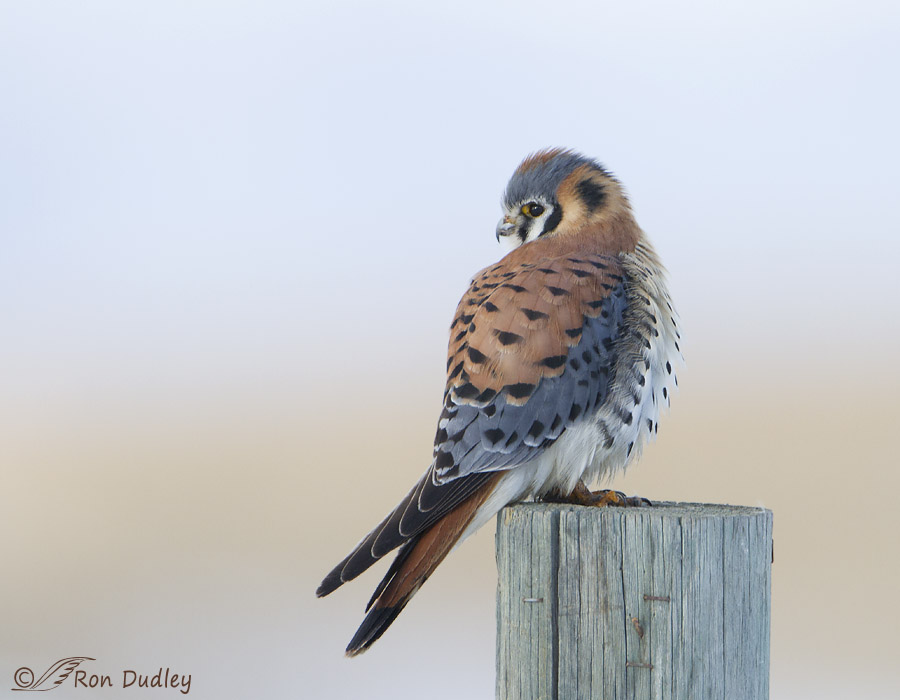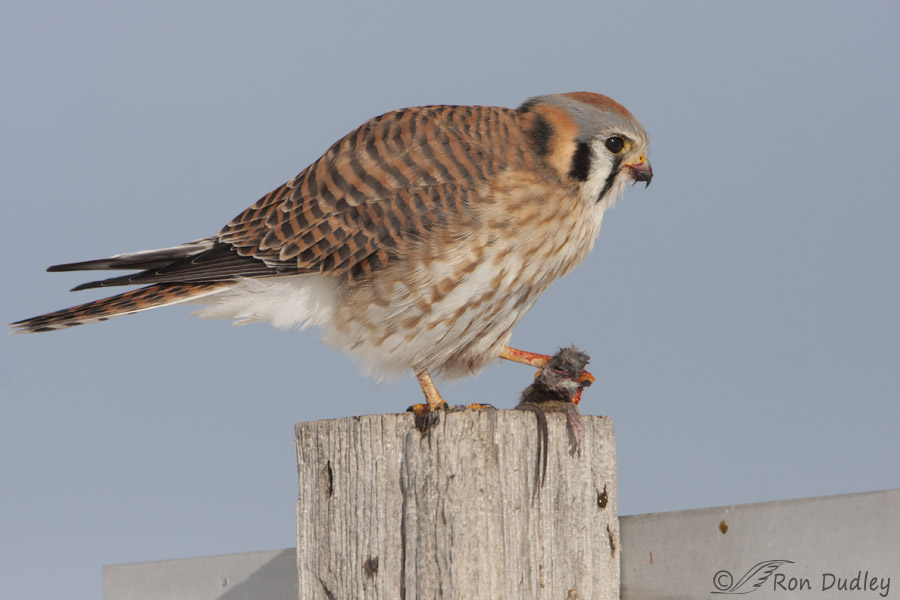Some falcons, hawks and owls have two ocelli (eye-like patches or “false eyes”) on the back of their head. Their function may not be as presumed.

1/640, f/6.3, ISO 640, Canon 7D, Canon EF500mm f/4L IS USM +1.4 tc, not baited, set up or called in
Despite the less than ideal perch I’ve always liked this image because the pose shows off most of the handsome dorsal plumage colors and patterns of the male American Kestrel so well and at the same time it still provides a good look at the face and eye. One of the two black ocelli on the back of the head can also be seen clearly.

The female kestrel with her sexually dimorphic plumage also has ocelli. I had to browse through thousands of my kestrel images to find one that shows at least part of both ocelli because I typically delete images that don’t show the face well (this image has poor composition because it’s full frame). When seen from the rear the ocelli can give the appearance of a “false face” on the back of the head.
It has long been presumed by many that the function of ocelli is to provide protection against attack by predators from the rear. Having been warned that the “owner” of the ocelli has likely seen them coming and will retaliate, a predator may abort an attack. But another somewhat related alternative theory has also been proposed.
Many raptors with ocelli prey largely on passerine birds. The “false face” may function in the hunting of small birds by provoking (or manipulating) their mobbing response. The advantage to the raptor may be immediate because it’s relatively common for mobbers to be killed and eaten by the raptor being mobbed. It’s also possible that the benefit to the raptor may be postponed if the raptor is actually using mobbing as a method of evaluating hunting prospects in the area.
Proponents of this second theory use research on pygmy owls as evidence. There are 26 – 35 species of pygmy owls worldwide (the exact number is disputed) and some of those species include a high proportion of small birds in their diets while others do not. Those pygmy owl species that prey mainly on passerines tend to have ocelli while those that do not, lack them. It is claimed that these findings are most consistent with ocelli being used to deceive mobbing birds so they can be more easily preyed upon.
Whatever the actual function(s) of the “false face” may be, the next time you see the bearer of one – wonder. As I do.
Birds are endlessly fascinating.
Ron


I believe it is very rare for a mobbing bird to be captured. Do you have evidence to the contrary? Raptors, like all predators, almost always catch their prey by surprise. If a potential prey item can see the predator, as can birds mobbing a raptor, it is my belief that they are relatively safe. They’re much smaller than the predator they’re mobbing, so they can out maneuver the larger raptor, should it initiate a prey capture attempt. I have watched countless mobbing events and have never seen a raptor being mobbed even try to catch a bird that was mobbing it.
“I believe it is very rare for a mobbing bird to be captured. Do you have evidence to the contrary?”
Rob, this scientific paper is where I obtained the “evidence” for what I said:
http://www.google.com/url?sa=t&rct=j&q=&esrc=s&source=web&cd=3&ved=0CC8QFjAC&url=http%3A%2F%2Fdigital.csic.es%2Fbitstream%2F10261%2F33914%2F1%2Fdeceptive%2520plumage%2520signals%2520in%2520birds%2520manipulation%2520of%2520predators%2520or%2520prey.doc&ei=TdV5VOGuMsfmoATlhYHgCg&usg=AFQjCNG8q6RSd8tFVeTrFMZrFYendXeI8w&sig2=pdU2TX_Pz0p03OuTBARRmQ&bvm=bv.80642063,d.cGU
Below is the quote from the introduction to the paper but the salient portion is this – “there are numerous accounts of mobbers being killed.”
“Most raptors with ocelli typically include a large proportion of passerine birds in their diets. The false faces may have evolved to aid in the hunting of small birds by actually provoking, or manipulating the nature of a mobbing response. The benefit of doing so may either be immediate because there are numerous accounts of mobbers being killed, or the benefit may be postponed if the predator is using mobbing as a means of evaluating hunting prospects in a given area.”
An internet search also provides other apparently well documented examples of raptors killing or attempting to kill mobbing birds. But precisely how “rare” it is, I of course don’t know…
We have a Kestrel pair at the raptor rehab center I volunteer for, and–I’m ashamed to admit–I’ve spent so much time admiring their faces/features/colors, I somehow never noticed the ocelli on either one! I’ve seen it on our Pgymy owl, because a handler pointed it out during an event presentation. Thank you for your photos and the lessons shared each day–birds *are* endlessly fascinating!
Chris, sometimes we miss the obvious because we’re so used to it that it doesn’t even register. It’s happened to me often.
Here the false eyes are used against birds – with variable success. In magpie swooping season it is not unusual to see people out and about with eyes painted on their helmets – and spikes sticking out as well. Sometimes it works sometimes it is an epic fail.
And yes, birds are endlessly fascinating. So much to learn. So much to marvel at.
I’ve heard about that strategy for your mobbing Australian magpies, Elephant’s Child. Interesting that it doesn’t always work, perhaps because magpies are smart enough to figure it out…?
This is one of my favorite birds. I’ve often thought about getting a tattoo of one (yep, I’m a tattooed woman, lol).
Tattoo up, Arwen!
Very interesting theory. I’ve never really thought about the function of ocelli before, and I find it fascinating that raptors might use mobbing as a way of hunting. That makes raptors even more interesting. As usual I’m glad that you used American Kestrel images to illustrate. I just got ‘mobbed’ by a couple of males, presumably this year’s babies, the other day when I was working in the garden. They were enjoying the wind right over our property and being quite noisy – a pleasant experience as always.
Susan, If one has to be mobbed by anything it seems that kestrels would make an excellent choice…
Super shots and interesting info Ron!
Charlotte
Thank you, Charlotte.
fascinating info!!
Thanks, Lois.
Thanks for the information on the second theory regarding ocelli. And for the great photos to illustrate it. The example of the pygmy owls with and without ocelli seems to substantiate the theory. Do you know if most other species with ocelli also prey on mobbing birds?
Justine, from what I’ve read it seems that most species with ocelli prey on small birds and since many small birds mob predators I would think that means they often prey on mobbing birds.
Interesting … I wasn’t aware of the second hypothesis.
Dave
I hadn’t been aware of it either, Dave – until I did a little research…
Excellent lesson professor, much appreciated.
Although I’ve known about ocelli I hadn’t given it much thought until now! I won’t be looking at a bird of prey without checking for ocelli from now on.
I think I already told you that I had a female Kestrel that I rescued and initially falconed with many years ago.
I do remember you mentioning that kestrel, Dick. For me, seeing the ocelli well is a consolation prize since it means I’m looking at the bird from behind and likely won’t get any good images of it…
Never being convinced one has the full answer sure keeps the door open – so good for the mind and spirit! I had never heard the second theory and appreciate learning it. Thanks so much, Ron, for the information that enriches your wonderful photos. Rich indeed.
Agreed, Alison – once that door is closed, learning tends to stop. Thanks.
Thank you for your wonderful photos and information! I shoot Canon also.
Thanks, Gena. I’m glad you found the information interesting/useful.
Ron, I have a Canon 70D and a 5D Mark III. I purchased a 7D Mark II and had lots of issues with the camera, as well as, not locking on birds in flight in AI Servo. I recall seeing you mention that you purchased one. How is yours working out? I sent mine back and am going to wait awhile before I repurchase it.
So far, so good, Gena but I haven’t given it much of a workout yet on birds in flight either. Hopefully that’ll change this morning as I’m about to head out…
Look forward to seeing your photos!!